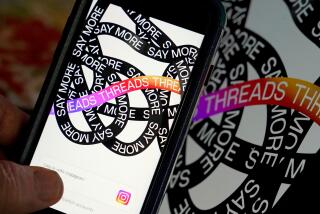Twitter drawing on lessons learned from Facebook IPO
- Share via
SAN FRANCISCO — Call it the anti-Facebook IPO.
It may be the most hotly anticipated initial public stock offering since Facebook Inc. But Twitter Inc. is doing all it can to distance itself from the Facebook fiasco, which has become a case study on how not to take your company public.
“Certainly the crew at Twitter has had ample opportunity to study recent history and draw whatever lessons they can from it,” said Kevin Landis, whose Firsthand Technology Value Fund has a substantial stake in the San Francisco social media company.
For one thing, Twitter is likely to price its shares more modestly so it has room to grow once it goes public, analysts say, and probably will offer a smaller percentage of the company than Facebook did to goose demand.
Twitter’s caution was apparent Thursday when it announced via a surprise tweet that it had confidentially submitted paperwork to begin selling stock to the public.
It was the antithesis of Facebook’s splashy announcement in February 2012, which gave investors an early and revealing glimpse into every aspect of its financial performance.
Each subsequent public filing received intense scrutiny, especially the one that raised worrisome questions about Facebook’s lack of mobile advertising revenue. Facebook sold $16 billion in stock to investors in May 2012, only to see its share price skid in the following months amid doubts about its ability to make money from its 1 billion users.
Twitter took advantage of a provision in the law that allows a company with less than $1 billion in annual revenue to keep its financial data under wraps from competitors and the media until it begins actively marketing its stock to investors.
By filing under the Jumpstart Our Business Startups, or JOBS, Act, Twitter can avoid the pitfalls that Facebook encountered while still stirring excitement over the IPO.
“Twitter gets to have its cake and eat it too,” said Landis, whose fund bought more than 1 million Twitter shares on the private market at an average cost of $17 a share. “Twitter gets to start the drumbeat for the stock without revealing too much.”
The process gives Twitter a greater measure of control than Facebook had, Altimeter Group analyst Charlene Li said. Twitter can consult with the staff at the Securities and Exchange Commission about providing numbers and estimates, and may be able to sidestep some of the pitfalls faced by Facebook.
“Twitter’s business model is really confusing. It’s not obvious how they make money,” Li said. “They can spend the next few months going out and educating the marketplace.”
The shroud of secrecy is an ironic touch for a company that prides itself on transparency — and it leaves prospective investors very little to go on.
“Twitter is a strong, fast-growing company that is increasingly important in the media industry while still being relatively small,” Pivotal Research Group analyst Brian Wieser said. “But we really know very little about it at this point in time. We don’t know how big its business in Japan is. We don’t know about its capital expenditures or its data center expenditures. We know far less than we need to know to make any real assessment.”
Twitter is seizing on an opportune moment to sell stock to the public — and it has Facebook to thank. Investors have warmed up to social media stocks, especially as mobile advertising revenue growth accelerates.
Facebook’s shares hit a record high of $45 this week, above the $38 IPO price. LinkedIn, the professional networking service, is trading at sky-high levels even after selling an additional $1 billion in stock to investors in a secondary offering.
That’s why Twitter is also working on a faster timetable. Most analysts expect Twitter to hold its IPO by December to take advantage of Facebook’s dramatic comeback with investors and LinkedIn’s continued success.
Twitter was built to send simple text messages on mobile devices, and has been growing rapidly. It said in December 2012 that it had 200 million active users, and there’s widespread speculation that it’s closing in on 300 million.
“Facebook and LinkedIn have done a tremendous amount of the work for Twitter in terms of establishing these types of businesses as important and worth investing in,” said Michael Scissons, chairman of Grid Ventures, an investment and business consulting firm.
Still, Twitter’s business is at a much earlier stage — it only began showing ads to its users in 2010 — and analysts say it has a lot to prove. Research firm EMarketer expects Twitter to increase advertising revenue 63% to $950 million in 2014 from $583 million this year. That’s up from $140 million in 2011.
It’s wildly popular with celebrities, musicians and politicians and has deep tentacles into the worlds of media, sports, politics and entertainment, but it’s confusing to new users.
And its business is not as easy to understand as Facebook, Wedbush Securities analyst Michael Pachter said.
“I’d say 90% or more of institutional investors are on Facebook, 20% or fewer are on Twitter,” Pachter said. “Twitter has a huge uphill battle to explain to the investing community what it does.”
Twitter makes most of its revenue from an ad called a “sponsored tweet,” which is given a prominent spot in users’ timelines, the streams of updates from the accounts they follow. Advertisers bid for their messages to appear in the timelines of certain demographics or with certain keywords.
The key challenge facing Twitter: Ads on Twitter only work on Twitter, Li said.
“That makes ad buying — and scaling to media buyers — more difficult,” she said.
But Twitter has an edge Facebook did not at the time of its IPO: Its mobile advertising business. Ads on smartphones and tablets are expected to make up more than half its revenue this year, according to EMarketer.
It also has the seasoned guidance of patient managers, Scissons said.
Dick Costolo, who took over as chief executive in October 2010, has taken his time putting in place the right executives and rolling out advertising products that generate results for marketers and don’t alienate users, Scissons said.
With the IPO, Twitter is looking to build a war chest to fuel its global expansion and take on Facebook, with which it competes for online advertising dollars and eyeballs.
It’s also a way for employees and investors to cash in their shares. Twitter has received more than $1 billion in venture funding. In recent months, Twitter put an airtight lid on selling shares on the private market.
More to Read
Inside the business of entertainment
The Wide Shot brings you news, analysis and insights on everything from streaming wars to production — and what it all means for the future.
You may occasionally receive promotional content from the Los Angeles Times.











